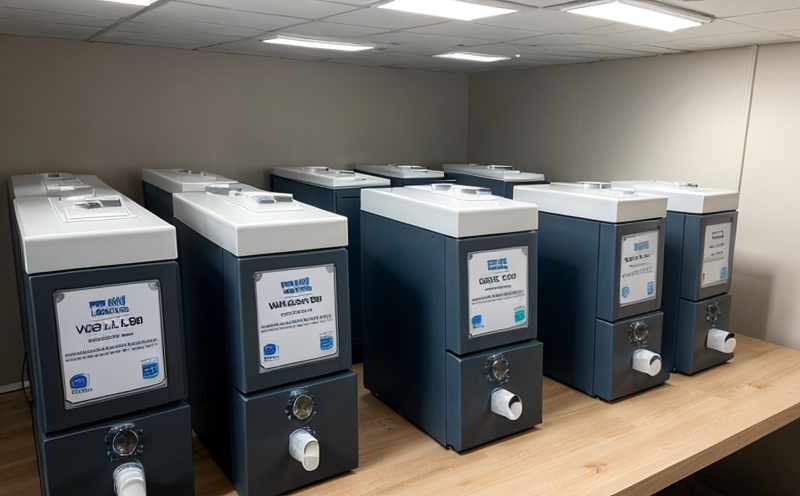VOC release evaluation in sportswear fabrics
Understanding and managing volatile organic compounds (VOCs) is crucial in the development of high-performance sportswear. Sportswear manufacturers need to ensure that their products are not only functional but also safe for consumers, especially regarding health implications associated with VOC emissions. This service evaluates the release of VOCs from fabric samples used in sportswear, ensuring compliance with international standards and providing data that can guide product improvement.
The process begins with the selection of appropriate test fabrics to represent real-world conditions. These fabrics must simulate the expected use in sports environments, which may include exposure to various types of physical stress, moisture, and temperature variations. The selection criteria are based on the specific demands of different sportswear categories such as running, cycling, or team sports.
Once the fabric samples are prepared, they undergo testing using advanced instrumentation capable of detecting trace levels of VOCs. This equipment is designed to mimic real-world conditions, allowing for accurate measurement of emissions under various scenarios that might be encountered during use. The data collected from these tests provides insights into how different factors influence VOC release, such as the composition of fabric fibers and the application of finishes.
The testing process also involves a rigorous quality assurance framework aimed at ensuring consistent and reliable results. This includes calibration of instruments before each test run, validation of methods against recognized standards like ISO 16000-7, and regular audits to confirm adherence to best practices. The goal is to ensure that the data generated can be relied upon for making informed decisions about material selection and process optimization.
From a sustainability perspective, understanding VOC emissions from sportswear fabrics contributes significantly to reducing environmental impact throughout the product lifecycle. By identifying sources of unwanted emissions early in development, manufacturers can implement changes that not only enhance safety but also promote more sustainable manufacturing practices. This service helps bridge the gap between technical performance and ecological responsibility, aligning with broader industry trends towards green chemistry and eco-friendly production processes.
The results from VOC release evaluations play a vital role in ensuring compliance with regulatory requirements set by governing bodies such as Oeko-Tex Standard 100 or REACH. These standards mandate strict limits on harmful substances including certain VOCs, and failure to meet these can lead to product recalls or even legal actions. Our service not only helps manufacturers stay ahead of regulatory changes but also builds consumer trust through transparent communication about the safety aspects of their products.
In conclusion, VOC release evaluation in sportswear fabrics is more than just a compliance exercise; it's an essential tool for innovation and sustainability. By leveraging cutting-edge analytical techniques and adhering to stringent quality controls, this service ensures that the fabrics used in sports apparel meet both current standards and future expectations. This approach fosters continuous improvement within the sector, driving towards safer and greener solutions.
Scope and Methodology
The scope of our VOC release evaluation service covers a wide range of sportswear fabrics used in various applications, including running shorts, cycling jerseys, and team sports uniforms. The methodology involves several key steps:
- Sample Preparation: Fabric samples are prepared to accurately represent the intended use in different types of sportswear.
- Instrumentation Setup: Advanced analytical instruments such as gas chromatography-mass spectrometry (GC-MS) are calibrated and configured for detecting trace levels of VOCs.
- Data Collection: Samples are exposed to controlled conditions that simulate real-world usage, including exposure to moisture, temperature changes, and physical stress.
- Analysis: Emitted VOCs are quantified using standardized methods aligned with international standards like ISO 16000-7. The data is analyzed to determine compliance with relevant regulations and industry best practices.
This comprehensive approach ensures that the evaluation process is robust, reproducible, and aligned with global standards. It also provides valuable insights into how different factors influence VOC release, enabling manufacturers to make informed decisions about material selection and manufacturing processes.
Quality and Reliability Assurance
Our commitment to quality and reliability is reflected in our stringent quality assurance framework for VOC release evaluations. This includes:
- Instrument Calibration: All instruments used are regularly calibrated against certified reference materials.
- Method Validation: Testing methods are validated according to international standards like ISO 16000-7 to ensure accuracy and precision.
- Audits and Reviews: Regular internal audits and peer reviews are conducted to maintain adherence to best practices.
- Data Verification: Data from each test is verified against established benchmarks before final reports are generated.
By implementing these measures, we guarantee that the results of our VOC release evaluations are reliable and can be trusted for decision-making purposes. This level of assurance is critical in maintaining compliance with regulatory requirements and fostering trust among stakeholders.
Environmental and Sustainability Contributions
The evaluation of VOC release from sportswear fabrics contributes significantly to environmental sustainability by:
- Reduction of Harmful Emissions: Identifying sources of unwanted emissions early in the development process allows for targeted interventions, reducing overall emissions during use.
- Informed Material Choices: Data from these evaluations help guide material selection towards more sustainable options that minimize environmental impact.
- Eco-Friendly Production Practices: Insights gained can be used to optimize manufacturing processes, leading to reduced waste and lower energy consumption.
- Consumer Confidence: Transparent communication about the safety aspects of products enhances consumer trust in eco-friendly practices.
By integrating VOC release evaluation into their product development cycles, manufacturers contribute positively to environmental sustainability while maintaining high standards of quality and performance. This holistic approach supports broader industry efforts towards greener chemistry and more sustainable manufacturing processes.





